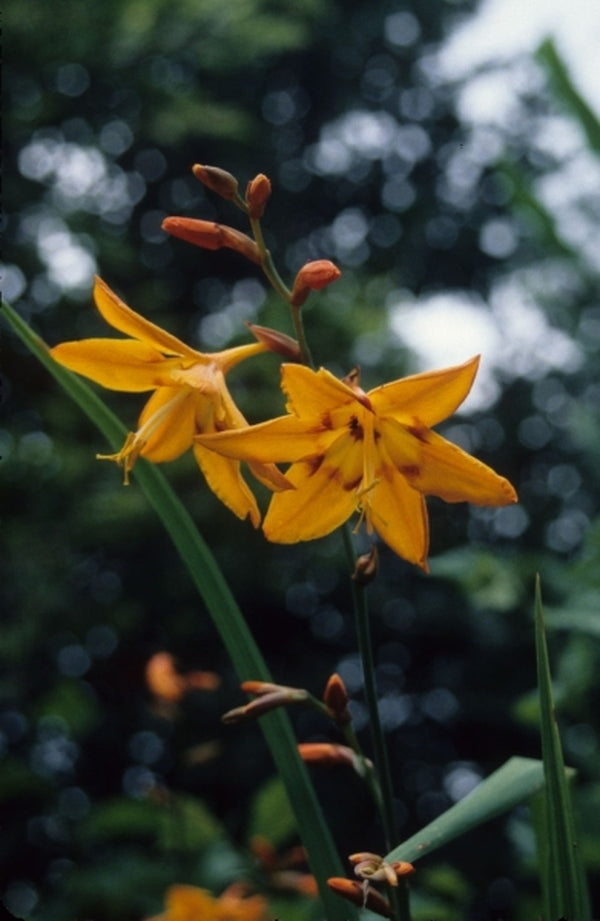Among the hundreds of crocosmia varieties, ‘Star of the East’ stands out as one of the most beloved. This award-winning montbretia showcases magnificent blooms in a vibrant orange hue.
In this article, we’ll explore why ‘Star of the East’ has remained so popular for over a century, examine its key features, and provide tips for growing this stellar plant
Overview
Crocosmia ‘Star of the East’ was introduced in 1910 by British nursery owner George Davison. It immediately caused a sensation in the gardening world with its large, bright orange flowers on sturdy upright stems.
This crocosmia grows 36-40 inches tall and blooms in mid to late summer. The blossoms emerge from buds of deep orange and open into wide, flaring trumpets revealing a creamy inner throat speckled with burgundy.
Each flower can reach 4 inches across making ‘Star of the East’ exceptionally large-flowered compared to other crocosmia varieties. The sword-like green foliage provides an attractive vertical accent.
Key Features
-
Large 4 inch wide flowers in vibrant orange
-
Blooms mid summer to early fall on strong upright stems
-
Introduced in 1910 and still popular today
-
Won the Royal Horticultural Society’s Award of Garden Merit
-
Attracts hummingbirds and butterflies
-
Tolerates heat, humidity, drought, and poor soil
-
Deer and rabbit resistant
-
Low maintenance
-
Suitable for borders, cutting gardens, and containers
Growing Conditions
‘Star of the East’ thrives in full sun to partial shade. It prefers moist, well-draining soil but is still quite drought tolerant once established. Like most crocosmias, it is adaptable to a wide range of soil types and conditions.
This montbretia grows well in USDA zones 6-9. Provide winter mulch in colder climates. It spreads slowly by underground corms but is not overly aggressive.
Plant the corms 3 inches deep and 6-8 inches apart in spring after the danger of frost. Water during dry spells. ‘Star of the East’ has few pest or disease issues, especially with adequate sunlight and air circulation.
Uses in the Landscape
Thanks to its long bloom season and bold color impact, ‘Star of the East’ has remained a go-to plant for gardens for over a century.
Its upright habit makes it ideal for:
-
Perennial borders and foundation plantings
-
Cottage gardens, cutting gardens, and wildflower meadows
-
Mass plantings for big color impact
-
Containers on decks, patios, and poolsides
-
Accent plantings with grasses, ferns, and dark-leaved plants
-
Attracting hummingbirds and butterflies to the landscape
Comparable Varieties
While ‘Star of the East’ remains a top choice, here are a few other large-flowered crocosmia varieties to consider:
-
Crocosmia ‘Solfatare’ – Deep yellow blooms
-
Crocosmia ‘Lucifer’ – Vibrant red flowers
-
Crocosmia ‘Emily McKenzie’- Red-orange with dark centers
-
Crocosmia ‘George Davison’ – Golden orange blooms
-
Crocosmia ‘Citronella’ – Lemon yellow flowers
Final Thoughts
With its brilliant orange color and incredibly large blooms on tall stems, it’s easy to see why crocosmia ‘Star of the East’ has been a beloved garden plant for over 100 years.
This rugged, low-maintenance montbretia offers weeks of vivid color in summer when many other perennials are fading. For gardens seeking sensational flowers that resemble flickering flames, look no further than the always outstanding ‘Star of the East’ crocosmia.
Item added to your cart
-

 Photo by JLBG taken at Juniper Level Botanic Gdn, NC
Photo by JLBG taken at Juniper Level Botanic Gdn, NC
Crocosmia, the colorful perennial with diabolical names – Gardening with Ciscoe
FAQ
Do crocosmia like sun or shade?
Where is the best place to plant crocosmia?
Do crocosmia plants spread?
Can you leave crocosmia bulbs in the ground?
- The Ultimate Guide to Growing Strawberries in Raised Beds - August 8, 2025
- No-Dig Garden Beds: The Easiest Way to Grow a Beautiful Garden - August 6, 2025
- How to Protect and Preserve Wood for Raised Garden Beds - August 6, 2025


